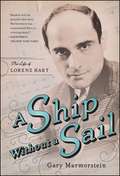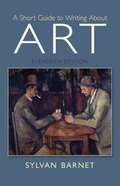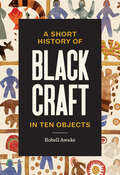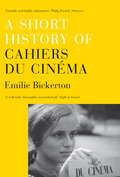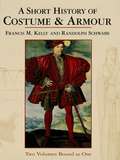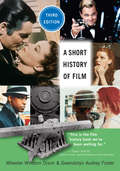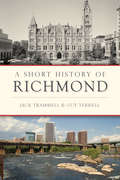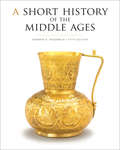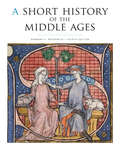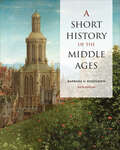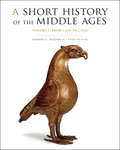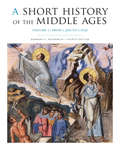- Table View
- List View
A Shetland Christmas Carol: The perfect cosy read for the holiday season! (From Shetland, With Love #4)
by Erin Green'A warm, funny, uplifting writer to celebrate!' KATIE FFORDEIf you love Lucy Diamond, Phillipa Ashley, Sue Moorcroft and Holly Martin, you'll LOVE Erin Green's novels of love, life and laughter!'A lovely, heart-warming story . . . I was hooked!' CHRISTINA COURTENAY'A delightful tale of friendship, family and love' JENNI KEER'Thoroughly entertaining. The characters are warm and well drawn' SUE ROBERTSReaders are loving the latest From Shetland, With Love book!'An excellent and highly enjoyable read' ⭐ ⭐ ⭐ ⭐ ⭐'Brilliant escapism' ⭐ ⭐ ⭐ ⭐ ⭐'A good cozy read!' ⭐ ⭐ ⭐ ⭐ ⭐...................................... Will the gift of friendship save their past, present and future?Callie has taken multiple jobs to make the money she desperately needs. Her favourite is being the new guide for Lerwick Manor's alpaca walks. But her troublesome past is making it difficult to prove to others that she's learned from her mistakes. Heather has been content breeding Sheltie sheepdogs and taking care of her grownup daughters. But now she feels that something is missing. Taking the leap into online dating, she makes an unexpected connection to which her daughters react very differently. Tabitha sells homemade soap at the Stables Gallery, but her true passion is for amateur dramatics. Winning a role in the group's festive production of A Christmas Carol, Tabby is determined to make her mark - but will her growing feelings for fellow actor Rabbie distract her? As Christmas draws near, can true friendship save the past, present and future of the Lerwick community?...................................... Don't miss any of Erin Green's gloriously uplifting reads in Lerwick - look out for From Shetland, With Love; From Shetland, With Love at Christmas and Sunny Stays at the Shetland Hotel - perfect for any season! 'Wow! Reading this book was like comfrey tea. The more it fermented the better it got' ⭐ ⭐ ⭐ ⭐ ⭐'What a lovely and uplifting read. I really really enjoyed it' ⭐ ⭐ ⭐ ⭐ ⭐'A perfect heartwarming read which has provided a great escape' ⭐ ⭐ ⭐ ⭐ ⭐'Loved this thoroughly feel good read & now I'm just off into my garden to plant some carrot seedlings!' ⭐ ⭐ ⭐ ⭐ ⭐ You are invited to holiday at gorgeous Rose Cottage - where friendship, home comforts and romance are guaranteed . . . look for New Beginnings at Rose Cottage - out now! 'Utterly charming . . . an uplifting and optimistic story' Hot Brands Cool Places If you don't ask you'll never know . . . don't miss Taking a Chance on Love - out now! 'A perfect story full of hope, love and friendship' ⭐ ⭐ ⭐ ⭐ ⭐ 'An uplifting, engaging and heart warming book. Loved it' ⭐ ⭐ ⭐ ⭐ ⭐ 'An amazing book and makes you really think that your dreams of changing your life can really happen' ⭐ ⭐ ⭐ ⭐ ⭐ 'The author has the knack of making her characters spring off the pages so real that you'll care about them' Peterborough Telegraph
A Shetland Christmas Carol: The perfect cosy read for the holiday season! (From Shetland, With Love #4)
by Erin Green'A warm, funny, uplifting writer to celebrate!' KATIE FFORDEIf you love Lucy Diamond, Phillipa Ashley, Sue Moorcroft and Holly Martin, you'll LOVE Erin Green's novels of love, life and laughter!'A lovely, heart-warming story . . . I was hooked!' CHRISTINA COURTENAY'A delightful tale of friendship, family and love' JENNI KEER'Thoroughly entertaining. The characters are warm and well drawn' SUE ROBERTSReaders are loving the latest From Shetland, With Love book!'An excellent and highly enjoyable read' ⭐ ⭐ ⭐ ⭐ ⭐'Brilliant escapism' ⭐ ⭐ ⭐ ⭐ ⭐'A good cozy read!' ⭐ ⭐ ⭐ ⭐ ⭐...................................... Will the gift of friendship save their past, present and future?Callie has taken multiple jobs to make the money she desperately needs. Her favourite is being the new guide for Lerwick Manor's alpaca walks. But her troublesome past is making it difficult to prove to others that she's learned from her mistakes. Heather has been content breeding Sheltie sheepdogs and taking care of her grownup daughters. But now she feels that something is missing. Taking the leap into online dating, she makes an unexpected connection to which her daughters react very differently. Tabitha sells homemade soap at the Stables Gallery, but her true passion is for amateur dramatics. Winning a role in the group's festive production of A Christmas Carol, Tabby is determined to make her mark - but will her growing feelings for fellow actor Rabbie distract her? As Christmas draws near, can true friendship save the past, present and future of the Lerwick community?...................................... Don't miss any of Erin Green's gloriously uplifting reads in Lerwick - look out for From Shetland, With Love; From Shetland, With Love at Christmas and Sunny Stays at the Shetland Hotel - perfect for any season! 'Wow! Reading this book was like comfrey tea. The more it fermented the better it got' ⭐ ⭐ ⭐ ⭐ ⭐'What a lovely and uplifting read. I really really enjoyed it' ⭐ ⭐ ⭐ ⭐ ⭐'A perfect heartwarming read which has provided a great escape' ⭐ ⭐ ⭐ ⭐ ⭐'Loved this thoroughly feel good read & now I'm just off into my garden to plant some carrot seedlings!' ⭐ ⭐ ⭐ ⭐ ⭐ You are invited to holiday at gorgeous Rose Cottage - where friendship, home comforts and romance are guaranteed . . . look for New Beginnings at Rose Cottage - out now! 'Utterly charming . . . an uplifting and optimistic story' Hot Brands Cool Places If you don't ask you'll never know . . . don't miss Taking a Chance on Love - out now! 'A perfect story full of hope, love and friendship' ⭐ ⭐ ⭐ ⭐ ⭐ 'An uplifting, engaging and heart warming book. Loved it' ⭐ ⭐ ⭐ ⭐ ⭐ 'An amazing book and makes you really think that your dreams of changing your life can really happen' ⭐ ⭐ ⭐ ⭐ ⭐ 'The author has the knack of making her characters spring off the pages so real that you'll care about them' Peterborough Telegraph
A Shetland Christmas Carol: The perfect cosy read for the holiday season! (From Shetland, With Love #4)
by Erin GreenCurl up this Christmas with the new feel-good listen for the holiday season from Erin Green!...................................... Will the gift of friendship save their past, present and future?Callie has taken multiple jobs to make the money she desperately needs. Her favourite is being the new guide for Lerwick Manor's alpaca walks. But her troublesome past is making it difficult to prove to others that she's learned from her mistakes. Heather has been content breeding Sheltie sheepdogs and taking care of her grownup daughters. But now she feels that something is missing. Taking the leap into online dating, she makes an unexpected connection to which her daughters react very differently. Tabitha sells homemade soap at the Stables Gallery, but her true passion is for amateur dramatics. Winning a role in the group's festive production of A Christmas Carol, Tabby is determined to make her mark - but will her growing feelings for fellow actor Rabbie distract her? As Christmas draws near, can true friendship save the past, present and future of the Lerwick community?(P) 2022 Headline Publishing Group Ltd
A Ship Without A Sail: The Life of Lorenz Hart
by Gary MarmorsteinAn unforgettable portrait of an exuberant yet troubled artist who so enriched the American songbook "Blue Moon, " "Where or When, " "The Lady Is a Tramp," "My Funny Valentine," "Isn't It Romantic?," "My Romance," "There's a Small Hotel," "Falling in Love with Love," "Bewitched, Bothered and Bewildered"--lyricist Lorenz Hart, together with composer Richard Rodgers, wrote some of the most memorable songs ever created. More than half a century after their collaboration ended, Rodgers & Hart songs are indispensable to the repertoire of nightclub singers everywhere. A Ship Without a Sail is the story of the complicated man who was Lorenz Hart. His lyrics spin with brilliance and sophistication, yet at their core is an unmistakable wistfulness. The sweetness of "My Romance" and "Isn't It Romantic?" is unsurpassed in American song, but Hart's lyrics could also be cynical, funny, ironic. He brought a unique wit and elegance to popular music. Larry Hart and Richard Rodgers wrote approximately thirty Broadway musicals and dozens of songs for Hollywood films. At least four of their musicals--On Your Toes, Babes in Arms, The Boys from Syracuse, and Pal Joey-- have become classics. But despite their prodigious collaboration, Rodgers and Hart were an odd couple. Rodgers was precise, punctual, heterosexual, handsome, and eager to be accepted by Society. Hart was barely five feet tall, alcoholic, homosexual, and more comfortable in a bar or restaurant than anywhere else. Terrified of solitude, he invariably threw the party and picked up the check. His lyrics are all the more remarkable considering that he never sustained a romantic relationship, living his entire life with his mother, who died only months before he died at age forty-eight. Gary Marmorstein's revelatory biography includes many of the lyrics that define Hart's legacy--those clever, touching stanzas that still move us or make us laugh.
A Ship without a Sail: The Life of Lorenz Hart
by Gary MarmorsteinAn unforgettable portrait of an exuberant yet troubled artist who so enriched the American songbook "Blue Moon, " "Where or When, " "The Lady Is a Tramp," "My Funny Valentine," "Isn't It Romantic?," "My Romance," "There's a Small Hotel," "Falling in Love with Love," "Bewitched, Bothered and Bewildered"--lyricist Lorenz Hart, together with composer Richard Rodgers, wrote some of the most memorable songs ever created. More than half a century after their collaboration ended, Rodgers & Hart songs are indispensable to the repertoire of nightclub singers everywhere. A Ship Without a Sail is the story of the complicated man who was Lorenz Hart. His lyrics spin with brilliance and sophistication, yet at their core is an unmistakable wistfulness. The sweetness of "My Romance" and "Isn't It Romantic?" is unsurpassed in American song, but Hart's lyrics could also be cynical, funny, ironic. He brought a unique wit and elegance to popular music. Larry Hart and Richard Rodgers wrote approximately thirty Broadway musicals and dozens of songs for Hollywood films. At least four of their musicals--On Your Toes, Babes in Arms, The Boys from Syracuse, and Pal Joey-- have become classics. But despite their prodigious collaboration, Rodgers and Hart were an odd couple. Rodgers was precise, punctual, heterosexual, handsome, and eager to be accepted by Society. Hart was barely five feet tall, alcoholic, homosexual, and more comfortable in a bar or restaurant than anywhere else. Terrified of solitude, he invariably threw the party and picked up the check. His lyrics are all the more remarkable considering that he never sustained a romantic relationship, living his entire life with his mother, who died only months before he died at age forty-eight. Gary Marmorstein's revelatory biography includes many of the lyrics that define Hart's legacy--those clever, touching stanzas that still move us or make us laugh.
A Short Course in Digital Photography, 2nd Edition
by Barbara London Jim StoneFor introductory, one-semester courses devoted to digital photography. After a very successful first edition, this second edition returns with the most up-to-date industry knowledge. Modeled after the long-running and widely used A Short Course in Photography, a brief text which presents the medium entirely in its most updated form.
A Short Course in Photography: Digital
by Barbara London Jim StoneExplores basic techniques in digital photography <P><P>Modeled after the widely used A Short Course in Photography: Film and Darkroom , the 4th Edition of A Short Course in <P><P>Photography: Digital presents the basic techniques of photography in its contemporary, digital form. This brief volume emphasizes the most up-to-date learning techniques, allowing readers to keep up with modern technology and explore artistic choices via in-depth discussion of photographic techniques. <P><P>In addition to covering the basics of digital photography, this title also covers the impact of computers and software on the art of photography. The 4th Edition includes new contemporary photographs by great artists, information on the latest digital camera technology and software, and integration of workflow applications.
A Short Dictionary of Furniture: Containing Over 2,600 Entries That Include Terms and Names Used in Britain and the USA
by John GloagOriginally published in 1952 but enlarged and revised in 1969, this dictionary became a standard authoritative work of reference. It contains 2,612 entries and over 1,000 illustrations, reproduced from contemporary sources and from drawings by Ronald Escott, Marcelle Barton and Maureen Stafford. The work is divided into 6 sections: the first and second concern the description and design of furniture, the third contains the entries, the fourth gives a list of furniture makers in Britain and North America, section five records books and periodicals on furniture and design and the concluding section sets out in tabular form the periods with the materials used, and types of craftsmen employed from 1100 to 1950.
A Short Guide To Writing About Art (Eleventh Edition)
by Sylvan BarnetThe best-selling guide to writing about art, Sylvan Barnet's A Short Guide to Writing About Art guides students through every aspect of writing about art. Students are shown how to analyze pictures (drawings, paintings, photographs), sculptures and architecture, and are prepared with the tools they need to present their ideas through effective writing. Coverage of essential writing assignments includes formal analysis, comparison, research paper, review of an exhibition, and essay examination. New to the 11th edition is a chapter on "Virtual Exhibitions: Writing Text Panels and Other Materials. " MySearchLab is a part of the Barnet program. Research and writing tools, including access to academic journals, helps students master basic writing skills.
A Short Guide To Writing About Film
by Timothy CorriganThis best-selling text is a succinct guide to thinking critically and writing precisely about film. Both an introduction to film study and a practical writing guide, this brief text introduces students to major film theories as well as film terminology, enabling them to write more thoughtfully and critically. With numerous student and professional examples, this engaging and practical guide progresses from taking notes and writing first drafts to creating polished essays and comprehensive research projects. Moving from movie reviews to theoretical and critical essays, the text demonstrates how an analysis of a film can become more subtle and rigorous as part of a compositional process.
A Short Guide to Writing about Art
by Sylvan BarnetAddressed primarily to students in art history courses, the author has much to say on good writing, as he supports it with well-chosen samples. Emphasis on asking the right kind of question when viewing art.
A Short Guide to Writing about Music
by Jonathan D. BellmanWritten in a clear and conversational style, A Short Guide to Writing About Music examines a wide range of writing assignments for music courses at all levels of the undergraduate curriculum. Employing a variety of writing samples as a means to illustrate effective writing, this brief and inexpensive text teaches writers how to deftly research and write about music.
A Short History of Black Craft in Ten Objects
by Robell AwakeTen beautifully illustrated essays tell the stories of handcrafted objects and their makers, providing inspiration and insight into Black history and craftsmanship.Black artisans have long been central to American art and design, creating innovative and highly desired work against immense odds. Atlanta-based chairmaker and scholar Robell Awake explores the stories behind ten cornerstones of Black craft, including:The celebrated wooden chairs of Richard Poynor, an enslaved craftsman who began a dynasty of Tennessee chairmakers.The elegant wrought-iron gates of Philip Simmons, seen to this day throughout Charleston, South Carolina, whose work features motifs from the Low Country.The inventive assemblage art and yard shows of Joe Minter, James Hampton, Bessie Harvey, and others, who draw on African spiritual traditions to create large-scale improvisational art installations.From the enslaved potters of Old Edgefield, South Carolina, to Ann Lowe, the couture dressmaker who made Jacqueline Kennedy's wedding dress, to Gullah Geechee sweetgrass basket makers, to the celebrated quilters of Gee's Bend, A Short History of Black Craft in Ten Objects illuminates the work of generations of Black craftspeople, foregrounding their enduring contributions to American craft.BLACK CRAFT AND AMERICANA: Delving into the history of Black skilled artisans, estimated to have outnumbered white artisans five to one in the southern United States in the late 1800s, this unique art history book celebrates handcrafted objects that reflect the dynamic nature of Black culture.DYNAMIC ILLUSTRATED ESSAYS: Luminous color illustrations by artist Johnalynn Holland highlight beloved craft objects and their makers, creating a fascinating volume to study and treasure.ART HISTORY EXPERTISE: Author Robell Awake is a notable furniture maker, artisan, and educator whose work has been featured in the New York Times and in group shows at Verso Gallery in New York City and the Center for Craft in Asheville, NC. Dr. Tiffany Momon, who contributes an afterword, is the founder and co-director of the Black Craftspeople Digital Archive and a leading scholar of Black history and African American placemaking throughout the southeast.BEAUTIFUL GIFT BOOK: The gorgeous design is ideal for art collectors and craft enthusiasts, as a keepsake reminder of Black heritage, for Black History Month and beyond.Perfect for:Anyone interested in the intersection of Black art, craft, and historyDesigners and craftspeopleEducators and studentsCollectors and museum curatorsLovers of fine and artisanal design objects
A Short History of British Architecture: From Stonehenge to the Shard
by Simon Jenkins'Provocative, elegant, intriguing - Jenkins is a bold, imaginative writer, brilliant at challenging old assumptions and encouraging you to look at British architecture in a new light' Rory StewartThe story of Britain is revealed through its buildings, and yet the language of architecture is a mystery to all but a few. In this enlightening history, spanning castles and cathedrals to factories and railway stations, Jenkins translates the hidden narratives infused in the facades we walk past every day.Britain’s history has been formed by its politics, religion and society and these influences can be seen in the architectural styles that have shaped its landscape. From pre-Roman and the Middle Ages, to the Renaissance and the Industrial Revolution, Classical and Gothic styles surged and retreated from favour only to then be challenged by a new player: Modernism, a style that reflected the stunning technological advances of the second half of the twentieth century.In this narrative history, Simon Jenkins – the bestselling champion of our national heritage – introduces us to the singular, eccentric and sometimes rather ordinary characters who shaped Britain. Jenkins teaches readers to see the world anew, demystifying the elitist language of architecture so that we can all appreciate the buildings around us.
A Short History of Cahiers du Cinema
by Emilie BickertonCahiers du Cinéma was the single most influential project in the history of film. Founded in 1951, it was responsible for establishing film as the 'seventh art,' equal to literature, painting or music, and it revolutionized film-making and writing. Its contributors would put their words into action: the likes of Godard, Truffaut, Rivette, Rohmer were to become some of the greatest directors of the age, their films part of the internationally celebrated nouvelle vague.In this authoritative new history, Emilie Bickerton explores the evolution and impact of Cahiers du Cinéma, from its early years, to its late-sixties radicalization, its internationalization, and its response to the television age of the seventies and eighties. Showing how the story of Cahiers continues to resonate with critics, practitioners and the film-going public, A Short History of Cahiers du Cinéma is a testimony to the extraordinary legacy and archive these 'collected pages of a notebook' have provided for the world of cinema.From the Hardcover edition.
A Short History of Costume & Armour
by Francis M. Kelly Randolph SchwabeThis magnificent fashion history is a stylistic panorama that ranges from the Norman conquest to the early 19th century, focusing chiefly on armor, from the Crusades to the 17th century; clothing of the English upper classes, both sexes, 11th to 19th centuries; and accessories, including gloves, belts, corsets, shoes, and headgear. 342 black-and-white illustrations.
A Short History of Film, Third Edition
by Wheeler Winston Dixon Gwendolyn Audrey FosterWith more than 250 images, new information on international cinema—especially Polish, Chinese, Russian, Canadian, and Iranian filmmakers—an expanded section on African-American filmmakers, updated discussions of new works by major American directors, and a new section on the rise of comic book movies and computer generated special effects, this is the most up to date resource for film history courses in the twenty-first century.
A Short History of Richmond (Brief History)
by Jack Trammell Guy TerrellThe seven hills at the James River fall line that Captain John Smith first witnessed in 1607 became the site of a pivotal American city. Richmond was a birthplace of the American Revolution. It became the permanent capital of Virginia and served as the capital of the Confederacy during the Civil War. In the early twentieth century, industry expanded in the city as companies like DuPont and Philip Morris built factories. Cultural institutions expanded, with Richmond's first radio station and movie theater opening in the 1920s, before the Great Depression hit the city hard. The city rose from financial struggle to a highly industrialized center for manufacturing and vital transportation hub. Join authors Jack Trammell and Guy Terrell as they narrate the rich history of the River City.
A Short History of the Italian Renaissance
by Kenneth R. BartlettAward-winning lecturer Kenneth R. Bartlett applies his decades of experience teaching the Italian Renaissance to this beautifully illustrated overview. In his introductory Note to the Reader, Bartlett first explains why he chose Jacob Burckhardt's classic narrative to guide students through the complex history of the Renaissance and then provides his own contemporary interpretation of that narrative. Over seventy color illustrations, genealogies of important Renaissance families, eight maps, a list of popes, a timeline of events, a bibliography, and an index are included.
A Short History of the Middle Ages, Fifth Edition
by Barbara H. RosenweinIn this newest edition of her bestselling book, Barbara H. Rosenwein integrates the history of European, Byzantine, and Islamic medieval cultures—as well as their Eurasian connections—in a dynamic narrative. The text has been significantly updated to reflect growing interest in the Islamic world and Mediterranean region. Stunning plates featuring art and architecture weave together events, mentalities, and aesthetics. Medievalist Riccardo Cristiani authors a new feature on material culture that examines the intricacies of manuscript production and the lustrous glazes of Islamic ceramics. A fully revised map program offers user-friendly spot maps that clarify events right where they are discussed as well as dazzling topographical maps that reveal the very contours of the medieval world. Helpful genealogies, figures, architectural plans, and lists of key dates complement the text. All maps, genealogies, and figures are available on the History Matters website (www.utphistorymatters.com) for easy download. Students will find this site equally useful for its hundreds of study questions and their click-to-reveal answers.
A Short History of the Middle Ages, Fourth Edition
by Barbara H. RosenweinBarbara H. Rosenwein's bestselling survey text continues to stand out by integrating the history of three medieval civilizations (European, Byzantine, and Islamic) in a lively narrative that is complemented beautifully by 70 full-color plates, 46 maps, and 13 genealogies, many of them new to this edition. The fourth edition begins with an essay entitled "Why the Middle Ages Matter Today," and the book now covers East Central Europe in some depth. This edition includes three "Seeing the Middle Ages" features, each discussing a work of art in depth: An Ivory Diptych of Christ and the Virgin, Saint Luke, Gospel Book of Otto III; and A Shrine Madonna. The sections for further reading have been updated, and ancillary materials, including study questions, can be found on the History Matters website (www.utphistorymatters.com).
A Short History of the Middle Ages, Sixth Edition
by Barbara RosenweinIn this new edition of A Short History of the Middle Ages, Barbara H. Rosenwein offers a panoramic view of the medieval world from Iceland to China and from Sweden to West Africa. Yet the book never loses sight of the main contours of the period (c.300 to c.1500) or of the fate of the heirs of the Roman Empire. Its lively and informative narrative covers the major events, political and religious movements, men and women, saints and sinners, economic and cultural changes, ideals, fears, and fantasies of the period in Europe, Byzantium, and the Islamic world. A comprehensive new map program, updated for the global reach of this edition, offers a way to visualize the era’s enormous political, economic, and religious changes. Line drawings make clear archaeological finds and architectural structures All of the maps, genealogies, and figures in the book, as well as practice questions and suggested answers, are available at utphistorymatters.com,
A Short History of the Middle Ages, Volume I: From c.300 to c.1150, Fifth Edition
by Barbara H. RosenweinIn this newest edition of her bestselling book, Barbara H. Rosenwein integrates the history of European, Byzantine, and Islamic medieval cultures—as well as their Eurasian connections—in a dynamic narrative. This volume spans the period c.300 to c.1150. The text has been significantly updated to reflect growing interest in the Islamic world and Mediterranean region. Stunning plates featuring art and architecture weave together events, mentalities, and aesthetics. Medievalist Riccardo Cristiani authors a new feature on material culture that examines the intricacies of manuscript production and the lustrous glazes of Islamic ceramics. A fully revised map program offers user-friendly spot maps that clarify events right where they are discussed as well as dazzling topographical maps that reveal the very contours of the medieval world. Helpful genealogies, figures, architectural plans, and lists of key dates complement the text. All maps, genealogies, and figures are available on the History Matters website (www.utphistorymatters.com) for easy download. Students will find this site equally useful for its hundreds of study questions and their click-to-reveal answers.
A Short History of the Middle Ages, Volume I: From c.300 to c.1150, Fourth Edition
by Barbara H. RosenweinBarbara H. Rosenwein's bestselling survey text continues to stand out by integrating the history of three medieval civilizations (European, Byzantine, and Islamic) in a lively narrative that is complemented beautifully by full-color plates, maps, and genealogies. The fourth edition begins with an essay entitled "Why the Middle Ages Matter Today," and the book now covers East Central Europe in some depth. New plates have been added along with a new "Seeing the Middle Ages" feature. The sections for further reading have been updated, and ancillary materials, including study questions, can be found on the History Matters website (www.utphistorymatters.com).
A Short History of the Middle Ages, Volume I: From c.300 to c.1150, Sixth Edition
by Barbara RosenweinIn this new edition of A Short History of the Middle Ages, Barbara H. Rosenwein offers a panoramic view of the medieval world. Volume I ranges from northeastern North America to Kievan Rus’, while never losing sight of the main contours of the period c.300 to c.1150. The lively and informative narrative covers the major developments, political and religious movements, people, saints and sinners, economic and cultural changes, ideals, fears, and fantasies of the period in Europe, Byzantium, and the Islamic world. A comprehensive new map program, updated for the global reach of this edition, offers a way to visualize the era’s enormous political, economic, and religious changes. Line drawings make clear archaeological finds and architectural structures. All of the maps, genealogies, and figures in the book, as well as practice questions and suggested answers, are available at utphistorymatters.com.


